The Ministry of Finance of Russia for the first time disclosed data on the salaries of employees of federal...

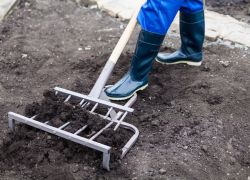
Every gardener knows how important proper and tillage is to get good results. Digging it twice a year, as well as harrowing after digging, loosening the soil are all ways of saturating it with oxygen, which has a positive effect on the yield of planted crops.
Each of these types of work requires its own garden equipment: a shovel, a rake, a chopper. And in order not to purchase all of them separately, it is better to have one tool that replaces them all in terms of functionality. It seems that this is from the realm of fantasy, but in fact such a tool has already been invented and is being used by gardeners with might and main. It is called the "miracle shovel" or "miracle pitchfork".
Such a tool has rich functionality, accommodating the capabilities of five different tools designed to care for the land:
In this case, you not only replace five tools, but also greatly simplify your work. For example, you have the opportunity to dig the earth to a certain depth or harrow in order to achieve a certain evenness of the earth's surface. And the long, complex process of digging turns into a quick and tireless task.
While working with a miracle shovel, your legs and arms will be involved, but not your lower back, since you do not need to squat and bend down. So your health after cultivating the land will be excellent.
You can not only dig and harrow the ground, but also rake leaves, branches, tops. You can dig up potatoes with ease and without damaging the root crops.
Of course, you can work with such a tool only on the land that you have been cultivating for more than a year. It is not suitable for processing virgin soil, because it cannot cope with a dense earthen clod.
Working with a miracle shovel is a real pleasure. You save a lot of time and energy. It is a large pitchfork that needs to be stuck into the ground and then lowered. At this point, the ground passes between the pitchfork and the metal pins. As a result, you simultaneously dig up and loosen the earth.
So, the process of digging with a miracle shovel consists of two simple movements - sticking the pitchfork into the ground and lowering the black. After each “digging”, the miracle shovel must be pulled back and moved row by row in this way.
Digging and loosening time takes three times less time than with traditional tools. And if the earth is soft and dry during processing, both a woman and an elderly person can handle it.
All miracle shovels, depending on the depth of loosening and the presence of additional elements, are divided into standard, "Mole" type and "Plowman" type. We will not consider ordinary ones, since they, as a rule, are made by hand and consist only of a pitchfork and a back gauge.

As for the differences between the Plowman and the Mole, the first shovel was invented mainly for loosening the earth. Its bayonet length is 10-15 cm, which makes it possible to process any type of soil without much effort. Whereas the “Mole” shovel has a large bayonet length - at least 25 cm, so it is suitable for deeper digging. The pothole made with its help can be immediately used for planting vegetables. And to work with such a tool already needs more effort.
There are also universal shovels with a bayonet length of 15-20 cm. They are suitable for high-quality processing of black soil, which in winter does not freeze deeper than 5-10 cm. It is difficult to work with them in more severe climatic regions.
Here's how to dig up a garden and not overwork at the same time? So that your back does not hurt and your hands do not shake after work? Is there a shovel for the lazy? Yes, such a miracle shovel has long been designed and is working with might and main in the dachas of craftsmen. Of course, at the behest of the pike, she will not turn the earth over, she will still have to apply the force, but on a much smaller scale. So that the reader can build this marvelous inventory with his own hands, we offer photos, videos and drawings.
The design is based on a support frame, to which two rippers are attached: the main and the auxiliary. The main ripper looks like a pitchfork, it is hinged to the frame with steel lugs. The rods of the auxiliary, or counter-ripper, are mounted rigidly on the frame and at such a distance that they enter exactly in the middle of the gap between the fork teeth. At the rear of the device there is a stop that allows you to transfer part of the effort to lift the soil onto the soil itself.
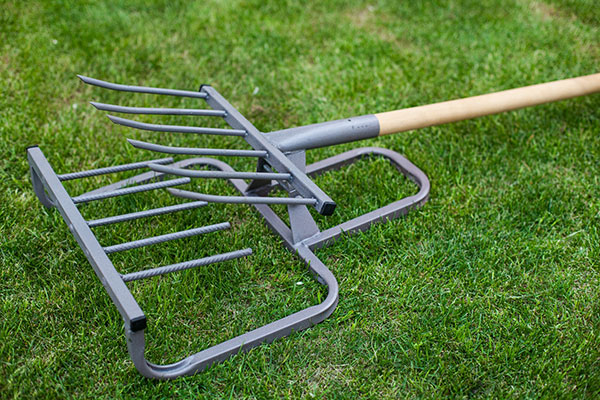
The miracle shovel is a support frame on which two rippers are fixed
When working, the support frame is placed on the ground and the stop is fixed with the foot so that the miracle shovel does not move to the side. The forks are thrust into the ground and, pressing on the handle, raise them. The soil breaks into large clods and breaks against the teeth of the auxiliary ripper. Then a step is taken back, the frame is pulled closer, and the operation is repeated.
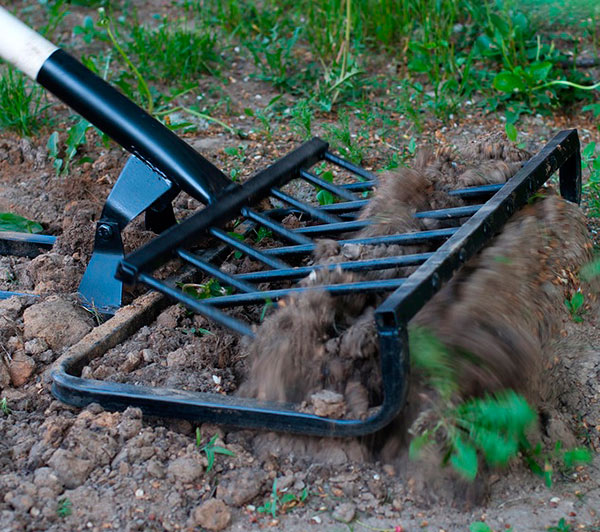
The pitchfork plunges into the ground and, pressing on the handle, raises them
This simple device allows you to process a large area by the standards of private gardening quickly, efficiently and without fatigue. Here is a partial list of Miracle Inventory achievements:
Attention! Do not try to dig up heavy soil with a miracle shovel during a drought. The tool will be broken and the earth will remain unloosened.
The ingenuity of folk inventors knows no bounds, so it is possible that this list will be replenished in the near future.
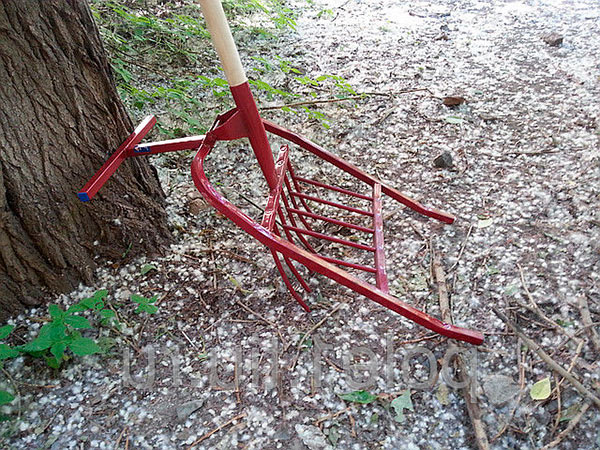
In the store, the miracle shovel costs several times more than its bayonet sister, so if you have a little bit of experience with welding equipment, you can make this advanced tool yourself.
For work you will need:
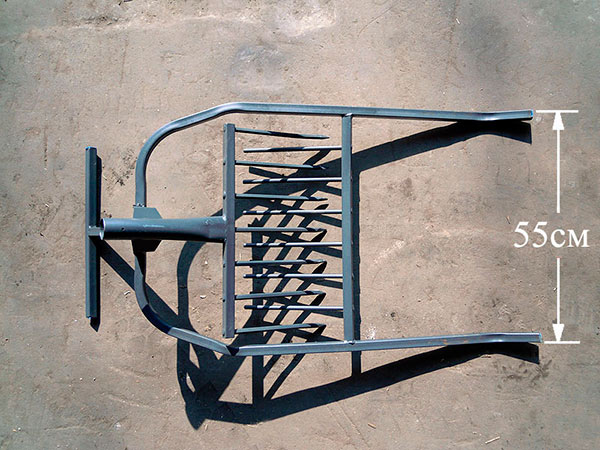
Advice. To make the shovel perform even better, sharpen the rods for the main ripper before welding.
In order for your new tool to please with its performance, you should remember that it is not omnipotent, and give it only such work that it can really do. The miracle shovel is not capable of digging a hole. You should not entrust her with figured digging around flower beds or other curvilinear elements of summer cottage arrangement. Since you need to press down on the handle with your weight to lift the fork, such a shovel is not suitable for a fragile teenager.
But if we are talking about fast, "with a twinkle", digging 10-20 acres for potatoes, then here the miracle shovel has no equal. And most importantly, the gardener will not even remember his lower back.
Do-it-yourself miracle shovel - video
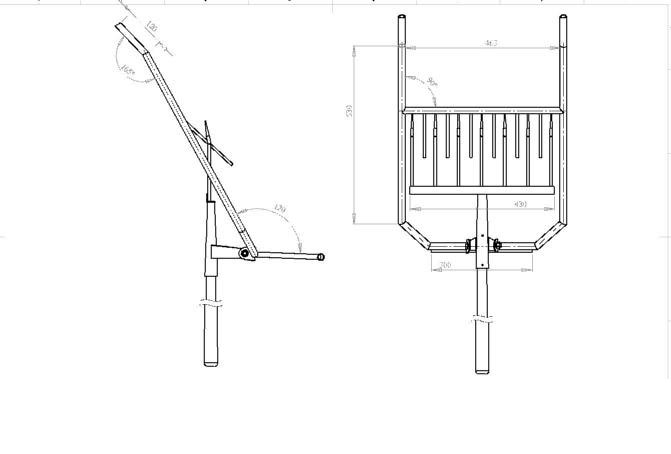
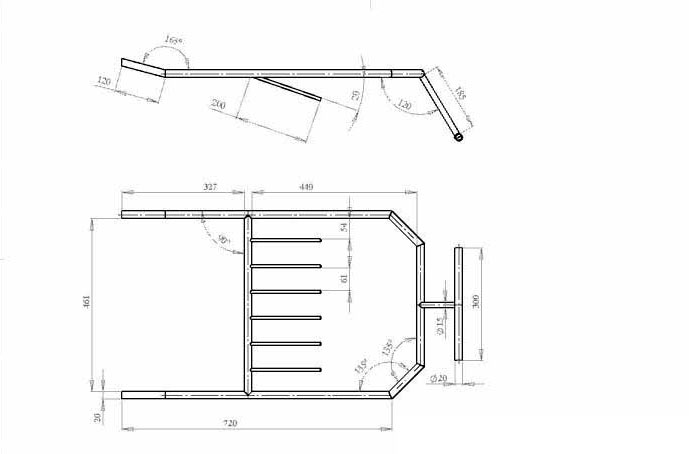
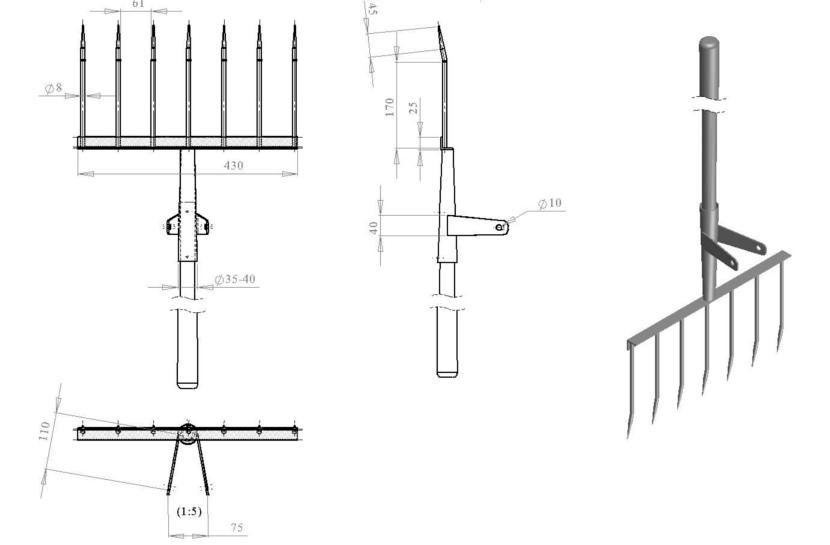
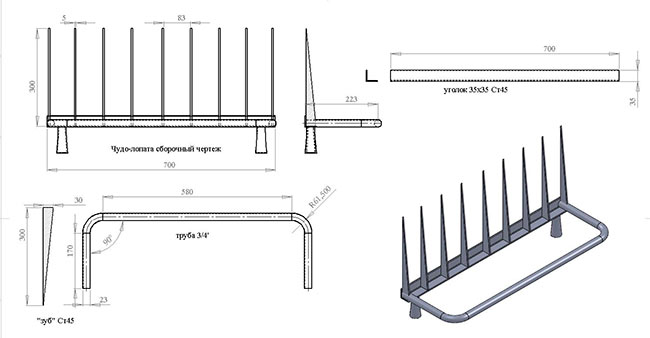
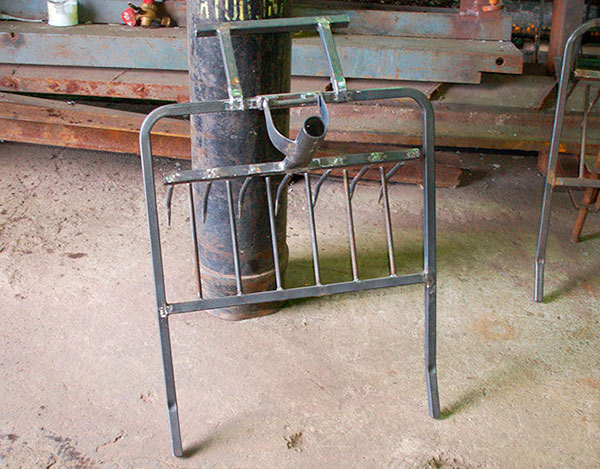
Not everyone knows how a miracle shovel is made with their own hands, but almost all summer residents and gardeners, owners of household plots know how difficult it is to dig up a garden. This procedure will be greatly simplified if you know how to make a miracle shovel with your own hands. It is worth noting that such a device is far from the only one in the arsenal of summer residents, there are others, however, it is it that allows you to significantly reduce the time of digging the site, save energy when working "in the field".
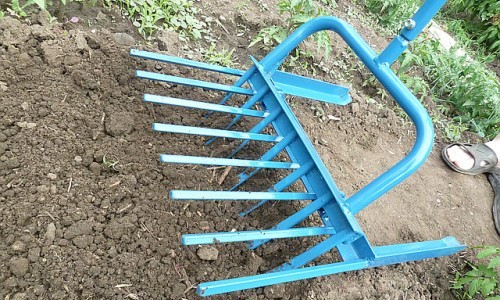
A miracle shovel is necessary for digging up a site in spring and autumn, before planting plants during gardening and dacha work.
The latter is especially important, since anyone who has encountered such work knows how difficult it is to perform. After all, intensive digging of the garden is not only difficult and tiring, but also detrimental to health. A home-made tool performs the functions of a conventional shovel much better and, according to the owners of this device, they can quickly and efficiently dig up the necessary piece of land.
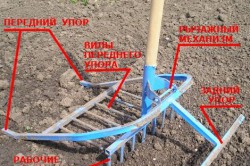
Many people believe that such a tool is capable of digging any soil, but this is a delusion. Such a device can only dig up areas with black soil or sand (soft soils), getting a stone (masonry remains, for example) under a shovel will stop work. Another misconception associated with this miracle item is that people consider such a device to look like an ordinary shovel. However, it is not. Such a device is more reminiscent of a pitchfork, a plow, a rake, the backs of beds (since they can be used in construction), but not a shovel. But the functions that this unit performs are similar to the functions of a bayonet shovel, which is used to dig up a site in spring and autumn, before planting plants during garden and country work.
Despite the fact that the tasks performed by such a device are similar to those of a shovel, and the principles of operation of these tools are similar, there are still differences that are very, very significant. So in the process of normal digging with standard garden tools, you need to apply considerable force and have great endurance (after all, you need to not only put the shovel on a full bayonet, but also get it with the ground), and when working with miracle equipment, you only need to lightly press the handle of the device and the ground loosens itself.
When working with a conventional tool, it becomes necessary to clean the surface of adhering earth and debris (humus, dry leaves, etc.), break up lumps of earth stuck together (if this is not done, then the dug up area will not be suitable for planting). Here, rods, fittings or pipes themselves dig and loosen the site. Even manufacturers of such devices in their commercials say that this design significantly reduces the load on the spine.
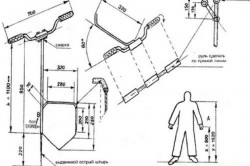
Also, such digging removes weed roots, small debris, etc. from the soil. This also saves time on weeding, as weeds will not grow in this case.
Many summer residents often confuse such a "wonderful" tool with another non-standard industrial product, which is called "Tornado". However, this is not correct, since the Tornado only loosens the soil, and does not dig it up.
The shovel itself structurally consists of a frame with longitudinal pins, which acts as a baking powder. A shovel frame is attached to the baking powder frame, and the connection must be movable. At the same time, the reinforcement rods on the frames should not coincide in location and ensure free movement. In this case, the second frame has a handle-lever, which is located at an angle to reduce the load and effort applied by the operator. However, this design has a number of technical difficulties that affect its operation.
Back to index
With all its advantages, this design has a number of disadvantages that most manufacturers hide and do not mention in commercials. These include the following:
![]()
To create a shovel, you need to stock up water pipe with a nominal bore of about 20-25 mm.
Based on the shortcomings of such devices described above, it is worth saying that such a device is not a “super” device for work. Like most other such "miracles", it can only work under certain conditions in areas with soft ground. Therefore, before you purchase or manufacture this tool, you must carefully weigh the pros and cons.
The beginning of the summer season is not only rest, but also a lot of work in the garden. Each summer resident tries to make the task of cultivating the soil as easy as possible for himself, for which various equipment is used. Recently, a miracle shovel, which you can make with your own hands, has gained wide popularity.
 The classic version of the miracle shovel is a bayonet shovel, which allows you to qualitatively process the soil of any complexity. Such a tool is a combination of a pitchfork and a sled, thanks to which it is much easier to plow the soil. Of course, it is much easier to use walk-behind tractors, electric cultivators or ask for help from a tractor driver whose machine is equipped with a plow. However, all these actions will require quite significant material costs from you, which is why most gardeners still prefer to work with their hands.
The classic version of the miracle shovel is a bayonet shovel, which allows you to qualitatively process the soil of any complexity. Such a tool is a combination of a pitchfork and a sled, thanks to which it is much easier to plow the soil. Of course, it is much easier to use walk-behind tractors, electric cultivators or ask for help from a tractor driver whose machine is equipped with a plow. However, all these actions will require quite significant material costs from you, which is why most gardeners still prefer to work with their hands.
Why is the miracle shovel so remarkable? The sharp teeth of the super-shovel easily enter the ground, and thanks to the lever (represented in the form of a long handle), large pieces of soil can be lifted, which will loosen on the second part of the forks located on the surface.
Based on the depth of loosening and the presence of additional elements, all such devices can be divided into three types: ordinary, such as "plowman" and type "mole".
Conventional shovels in most cases are made at home and consist of a pitchfork and a back gauge. When using such a tool, you can really reduce the load and increase the speed of work, but such a shovel will not solve the problem with large blocks of earth. It is suitable only for work on regularly cultivated black soil.
 The miracle shovel of the plowman type is designed not only for digging the earth, but also for better loosening the soil. The length of its bayonet is usually 10-15 cm, which makes it easy to cut any type of soil, and the bayonet calmly enters the ground even with a worker weighing no more than 60 kg.
The miracle shovel of the plowman type is designed not only for digging the earth, but also for better loosening the soil. The length of its bayonet is usually 10-15 cm, which makes it easy to cut any type of soil, and the bayonet calmly enters the ground even with a worker weighing no more than 60 kg.
The depth of the bayonet of a mole-type shovel is at least 25 cm and is intended for deep digging. The pothole is immediately used for planting vegetables. In the case of using this particular tool, a certain effort will be required from the digger, especially if you have to work on compressed soil or alumina.
Important! In addition to the described options for miracle shovels, there are also universal options, the bayonet length of which is from 15 to 20 cm. They are great for regions where the soil can freeze by 5-10 cm, and the main type of soil is chernozem (burozem). If the climatic conditions of the region turn out to be even more severe, then even such a depth of spade bayonets will not be enough, and you will not be able to renew the soil in a quality manner.
How to dig with a miracle shovel? We note the convenience of its use: you will not need to bend down, and the risk of back injury is minimized (this is especially true for people with sciatica). The required physical effort also decreases, and the speed of work, on the contrary, increases. The procedure for working with an improved shovel is as follows.
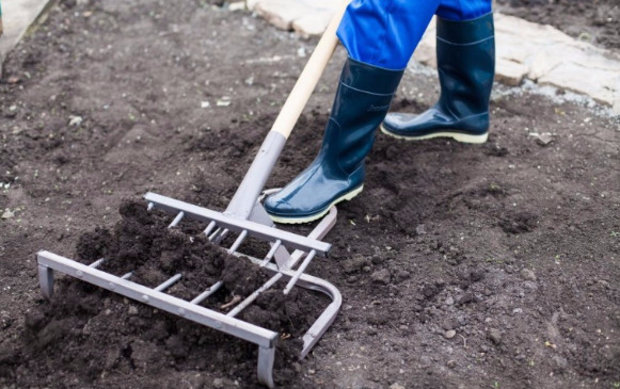 By pressing the foot on a special platform, it is necessary to deepen the shovel into the ground. Without removing your foot from the platform, take a step back with your other foot, at the same time tilting the shovel towards you - the soil will be on the teeth. Light shaking of the left and right hand shake off the soil, thus performing loosening. You can turn the soil over with one sharp upward movement of the hand, moving the shovel 10-15 cm back. After completing several approaches, you need to walk around the site with a rake and break up the clods.
By pressing the foot on a special platform, it is necessary to deepen the shovel into the ground. Without removing your foot from the platform, take a step back with your other foot, at the same time tilting the shovel towards you - the soil will be on the teeth. Light shaking of the left and right hand shake off the soil, thus performing loosening. You can turn the soil over with one sharp upward movement of the hand, moving the shovel 10-15 cm back. After completing several approaches, you need to walk around the site with a rake and break up the clods.
Did you know? The obsolete name for the modern shovel is the spade. It came from the definition of the type of action "to step in, step in with the foot", that is, to press on a metal bayonet.
In factory models of shovels, moving parts are often clogged with earth, which makes them work worse. In addition, wooden handles that are inserted into special sockets sometimes break. In homemade tools, all parts are connected quite rigidly, due to which breakages and jamming are almost completely excluded. However, this does not mean at all that the miracle shovel for the garden, which was made by hand, is completely devoid of flaws. There is a serious possibility of deformation of soldering or welding seams and breakage of plastic parts (if any), although such malfunctions appear only after many years of active use.
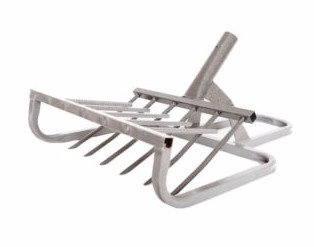 There are several important points which should be taken into account when self-manufacturing wonder shovels. The length of the bayonet to which it will enter the soil depends on the depth of freezing of the soil. In cases where the use of a shovel is necessary only for loosening the soil, 10 cm will be enough, but for planting vegetables, you will have to dig deeper (at least the teeth should go into the frozen soil layer by 5 cm). The width of the future miracle shovel depends on the estimated area of land capture.
There are several important points which should be taken into account when self-manufacturing wonder shovels. The length of the bayonet to which it will enter the soil depends on the depth of freezing of the soil. In cases where the use of a shovel is necessary only for loosening the soil, 10 cm will be enough, but for planting vegetables, you will have to dig deeper (at least the teeth should go into the frozen soil layer by 5 cm). The width of the future miracle shovel depends on the estimated area of land capture.
Important!The width of the tool should not exceed 50 cm, otherwise it will take too much effort. When choosing the necessary materials to create your own miracle shovel, you need to remember that industrial models are based on the use of a pitchfork, but not the usual two- or three-pronged ones, but wider ones (from 35 cm). With a step between the working rods, about 5 cm is formed, which is seven teeth a quarter of a meter long. It is clear that this is not the whole miracle shovel, and the drawing, which will be presented below, shows many other equally important details.
So, to create the described tool with your own hands, you will need:
Did you know? The name of the person who invented the miracle shovel is not known for certain, although there is an opinion that it was developed in Yekaterinburg.
Before proceeding with the independent manufacture of a miracle shovel, you need to pay attention to the main design features of such a tool. In most models, the forks are movably mounted on a forward-facing, horizontal frame, supplemented by an emphasis at the rear (in some cases, the frame is replaced with a sled slightly curved upwards). Oppositely directed rods are missed between the teeth, which are more reminiscent of a rake.
The tool may have two handles, but in most cases it is an ordinary handle, like a shovel or the same pitchfork. However, not in all cases a wooden handle is used, since such a lever can easily break (the teeth often cling to the roots). Instead of a handle, a metal pipe (for example, aluminum) can be installed. If the wooden handle breaks in the garden tool nest, at its very base, then it will be quite difficult to remove the chip, and the only way out is to try to drill it out.
There are also more simplified models, the design of which includes only a frame, which is also a stop (placed behind the working part). The teeth are fixed directly to the front bar, at the ends of which there are fasteners for the other two handles. This version of the miracle shovel is most often made at home.
Did you know? In the old days, a standard wooden shovel (or, as it was also called, “blade”) had a width of 6-14 inches and a length of 8-16 inches, and this with a total length with a handle of 1½-1¾ arshins. In Russia, all shovels and blades were hewn mainly from aspen, sometimes from linden or birch, and even more rarely from oak or maple.
When making a miracle shovel on your own, first of all, you need to create bayonets, for which the reinforcement prepared in advance is cut into segments of the desired length. The ends of these pieces are sharpened on one side at an angle of 30 °, although if the soil in your area is soft, then the bevel angle can be reduced to 15 ° (although this will lead to frequent blunting of the cutting part).
Having the required bayonets on hand, you can proceed to the creation of a carrier bar, for which a part of a square pipe is cut off. It is also worth preparing a round hollow pipe, which in the future will play the role of a handle. All elements are welded according to the drawings below.
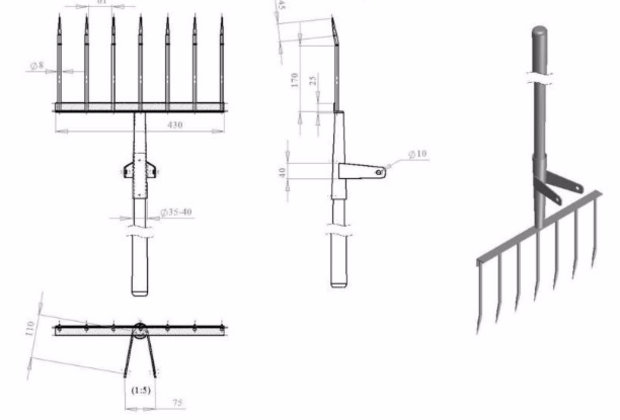
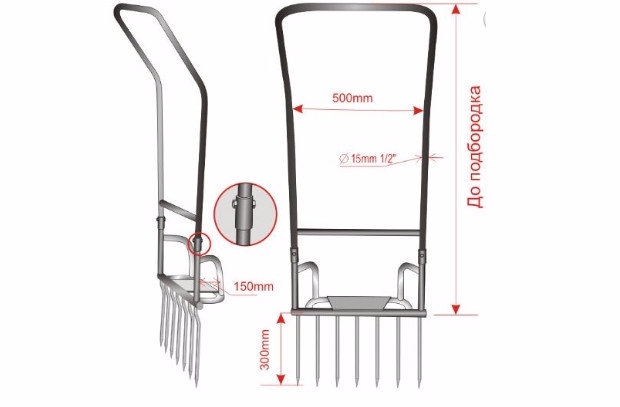
So, we have already figured out how to make a miracle shovel ourselves, and what you may need for this. But is this tool really necessary in the economy? It is necessary to take into account all the advantages and disadvantages of such a design.
The miracle shovel is much more convenient to use than its other counterparts, because it:
There are also design flaws, these include the following:
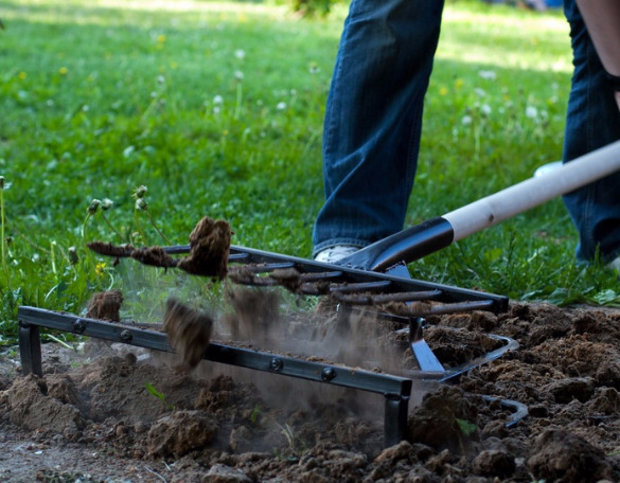 The tool is just perfect for arable work. Based on the length of the bayonets on the main forks, the pothole is used either for loosening the soil or for sowing. So, a depth of 15-25 cm (exact figures depend on the level of soil freezing) will be quite enough for planting potatoes, cabbage, corn and most vegetable crops. However, given that tomatoes, peppers and cucumbers are planted immediately as seedlings, they will have to manually create separate holes. In the garden, a miracle shovel will be useless: it is not suitable for digging trees and creating neat holes.
The tool is just perfect for arable work. Based on the length of the bayonets on the main forks, the pothole is used either for loosening the soil or for sowing. So, a depth of 15-25 cm (exact figures depend on the level of soil freezing) will be quite enough for planting potatoes, cabbage, corn and most vegetable crops. However, given that tomatoes, peppers and cucumbers are planted immediately as seedlings, they will have to manually create separate holes. In the garden, a miracle shovel will be useless: it is not suitable for digging trees and creating neat holes.
Summing up all of the above, it should be noted that such equipment will definitely come in handy for owners of gardens used for growing vegetables, and the area of \u200b\u200bthe cultivated area should not be less than fifty, otherwise it will be easier to do the work with a conventional shovel.
Was this article helpful?
Not really
With the onset of the summer season, every summer resident faces the problem of digging up the garden. Everyone remembers very well that such “physical education” is fraught with pain in the muscles, back and joints. But the earth must not only be dug up, but also loosened. This hard work sometimes seems endless and is completely unbearable for an elderly person. How to be? After all, everyone wants to have a well-kept backyard.
For such work, it is possible to attract any mechanized means, but their disadvantages are high cost and the fact that if the work is carried out at a time when weeds have already appeared, the involvement of such equipment increases their number at times, because even uprooted and cut into small pieces, they easily take root again and multiply.
We would like to bring to your attention - Miracle Shovel for the lazy- a simple, high-quality and inexpensive way to avoid monotonous, tedious and sometimes traumatic work to put in order the backyard territory. Let's say, not without pride, that this novelty was developed and produced in the Russian Federation.
A shovel-ripper is a lever-type mechanical structure, consisting of a frame and two forks directed towards each other. The principle of its operation is based on increasing productivity while minimizing the effort expended through the use of lever mechanisms.
Advantages
Types of miracle shovels:
made of high quality steel in Yekaterinburg, has a frame length of 780 mm.
For the convenience of customers, it is available in 3 sizes:
Loosening depth (length of working fork) -230 mm
Advantages: Unlike other shovels, the Plowman has the longest stop levers, which makes the work even less labor-intensive.
is made from high-strength steel in Chelyabinsk. Has a frame length of 520 mm.

Available in 3 sizes:
Loosening depth (length of working fork) -250 mm
Advantages: Due to the larger footprint than other shovels, there is no excessive immersion in the ground, which avoids unnecessary work.
produced in Chelyabinsk and has 3 modifications. Let's take a look at them. Working fork length (loosening depth) for all models 250 mm

Advantages: Designed for 2 cuttings with a transverse height-adjustable handle. That is, the fundamental difference between this shovel is that equal efforts are applied with both hands, which is very significant for people with diseases of the spine. When working with this model, the lower back will be practically motionless.
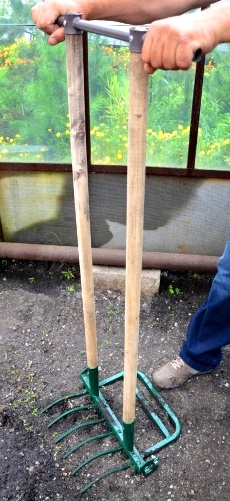
So, having considered all the possible options, we were convinced of the undoubted merits of the so-called "Miracle of a shovel for the lazy", it remains only to choose the one that suits you.
What do you need to know?